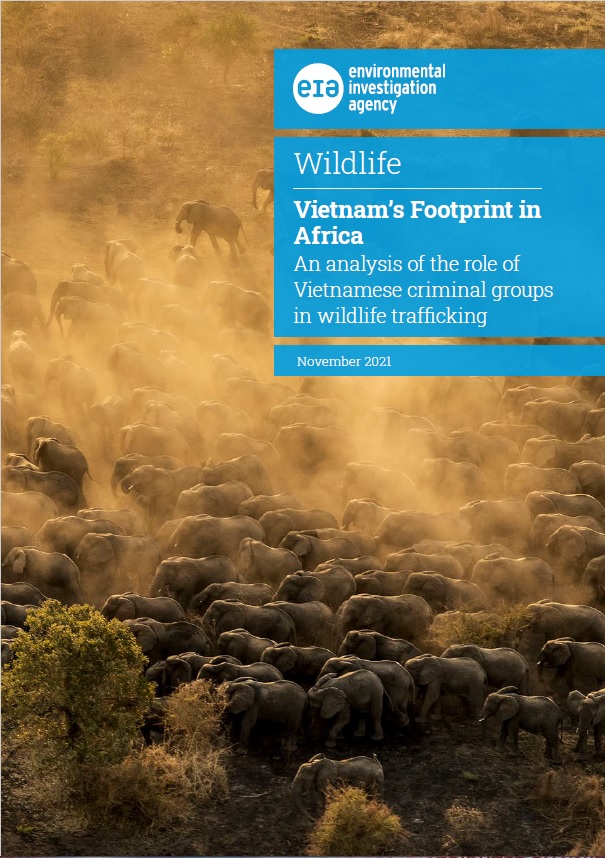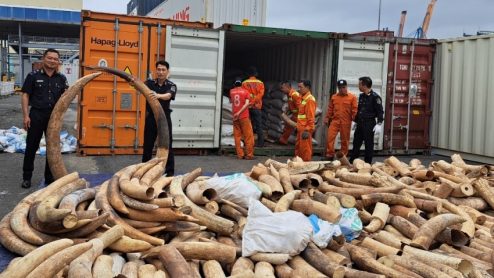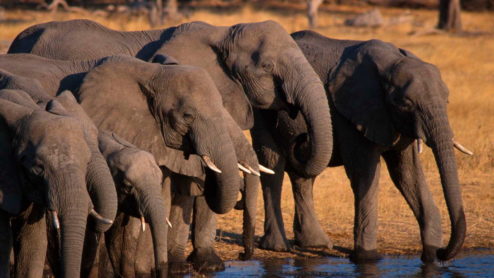Large ivory seizure in Mozambique comes amid worrying signs of increasing elephant poaching
A major shipment of 651 pieces of elephant ivory has been seized in Mozambique en route to Dubai.
Officials from Mozambique’s Criminal Investigation Service (SERNIC) and the Tax Authority intercepted a container at Maputo port on 22 March 2024 and found the ivory concealed in a shipment of bags of corn.
This is the third known large-scale seizure of elephant ivory exported from Mozambique since 2022. In May 2023, Tanzanian authorities confiscated 166 tusks arriving from Pemba airport to the north of Mozambique, just one year after Malaysian Customs seized six tonnes of ivory alongside other wildlife, including rhino horns and pangolin scales, exported from Maputo port.

The elephant ivory seized in Mozambique
EIA congratulates the Mozambique Government on this latest successful seizure and welcomes its commitment to disrupting illegal wildlife trade.
However, seizures must be followed up with prosecution outcomes based on robust, coordinated and appropriately applied criminal investigation procedures and analysis in order to actually disrupt and deter the criminal networks behind the illegal trade.
Conducting DNA analysis and tusk marking analysis is crucial to determine the provenance, or source, of the tusks in order to rule out leakage or theft from government stockpiles and to shed light on possible regional trafficking trends.
Theft of ivory from stockpiles is not unheard of in Mozambique, with almost a third of the total three tonnes of ivory it held having been stolen in 2018, leading to the arrest of Customs officials at Maputo port.
As a Category B Party to the Convention on International Trade in Endangered Species (CITES) National Ivory Action Plan (NIAP) process, Mozambique is required to implement robust timebound actions and measures to protect elephants from poaching and illegal ivory trade, but there has been little progress in its NIAP implementation.
 It is particularly concerning in the context of this recent seizure that Mozambique has not made sufficient progress, as directed under CITES, to investigate Vietnamese-led criminal syndicates involved in devastating poaching and trafficking in the region (see EIA’s report Vietnam’s Footprint in Africa).
It is particularly concerning in the context of this recent seizure that Mozambique has not made sufficient progress, as directed under CITES, to investigate Vietnamese-led criminal syndicates involved in devastating poaching and trafficking in the region (see EIA’s report Vietnam’s Footprint in Africa).
Under the NIAP process, Mozambique has also been asked to strengthen international law enforcement cooperation with key transit and consumer countries, particularly Vietnam, and to undertake joint operations and to strengthen information and intelligence exchange in order to more effectively disrupt ivory and rhino horn trafficking.
Unfortunately, there appears to have been no tangible cooperation between Mozambique and Vietnam, despite the adoption of a mutual legal assistance treaty (MLAT) between the two countries in 2018. At the regional level, in the past six months, there have been several incidents of serious concern in other countries, including Kenya, Botswana and Namibia, suggesting an increase in elephant poaching and illicit ivory trafficking in Eastern and Southern Africa.
EIA calls on countries in the Eastern and Southern African regions to rapidly strengthen regional and international cooperation and intelligence-sharing to disrupt transnational organised wildlife crime networks and ensure robust law enforcement responses to protect elephants from poaching for the illegal ivory trade.
Elephant populations across the continent have not yet fully recovered from the poaching crisis in the late 1990s to mid-2010s – another wave of poaching for the ivory trade could sound the death knell for some populations of these iconic species.



